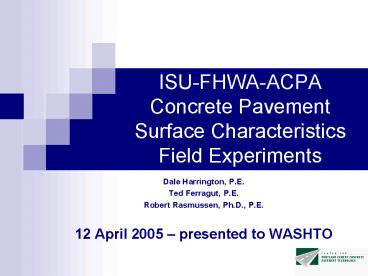ISUFHWAACPA Concrete Pavement Surface Characteristics Field Experiments - PowerPoint PPT Presentation
1 / 24
Title:
ISUFHWAACPA Concrete Pavement Surface Characteristics Field Experiments
Description:
ISU-FHWA-ACPA. Concrete Pavement Surface Characteristics. Field ... John Roberts. Gary Aamold. Terry Kraemer. FHWA. Mark Swanlund. Tom Harman. Project Team ... – PowerPoint PPT presentation
Number of Views:37
Avg rating:3.0/5.0
Title: ISUFHWAACPA Concrete Pavement Surface Characteristics Field Experiments
1
ISU-FHWA-ACPAConcrete Pavement Surface
CharacteristicsField Experiments
- Dale Harrington, P.E.
- Ted Ferragut, P.E.
- Robert Rasmussen, Ph.D., P.E.
- 12 April 2005 presented to WASHTO
2
Presentation Outline
- Background
- Partners
- Experimental Plan
- Timeline
3
Background
- Concrete Pavement Roadmap
- Track 4 Pavement Surface Characteristics
- International Scan Quiet Pavement Systems
- Quiet Pavement Pilot Program
4
ISU FHWA
- FHWA and ISU (PCC Center) cooperative agreement
- June 2004
- Supports Scan Implementation
- Advance SC Research Track, with stakeholders,
to optimize desirable surface characteristics
that includes low noise, high smoothness,
acceptable friction and where possible, reduced
splash and spray.
5
ACPA
- ACPA joined the FHWA and ISU team
- January 2005
- Coordinate and finance the field experiments
program. - The ACPA Chapter-States have joined this endeavor
by making noise the number one priority, and
serving as local ambassadors.
6
Staffing / Coordination
Co-principal investigators Mr. Dale Harrington
P.E. Mr. Ted Ferragut, TDC Partners, Ltd.
Technical Team Dr. Robert Rasmussen, The
Transtec Group Mr. Steven Karamihas, UMTRI Dr.
Bob Bernhard, PurdueAdditional assistance as
required
7
Project Team
- ACPA / IGGA
- Jerry Voigt
- Mike Ayers
- Larry Scofield
- John Roberts
- Gary Aamold
- Terry Kraemer
FHWA Mark Swanlund Tom Harman
8
Partnership
- Management purpose
- Leverage experiences.
- Implement the Quiet Pavements Scan.
- Leverage funds.
- Promote teamwork.
- Technical purpose
- Understand texture/noise relationship
- Develop texture/noise time relationship
- Develop construction techniques
9
FHWA ISU ACPA
- Research Gap
- Very little systematic information exists to
explain the sensitivity of noise to the specific
dimensions of each type of texture/grinding,
including - directionality, channel width and depth,
aggregate size, mix type, construction techniques - Nearly all previous experiments have fallen short
due to lack of consistent noise and texture
measurements.
10
Field Experiments
- Prepare biddable specification packages, testing
plans, and inspector guidelines - Organize field experiments
- 2005 Texturing and Grinding
- 2006 Exposed Aggregate Porous Concrete
11
Texturing /Grinding Study
- Type 1. New Construction
- Measure noise, texture, smoothness, friction, and
concrete early, frequently, simultaneously - Output construction details and rate of change
- Type 2. In Service (less than 2 years old)
- Measure noise, texture, smoothness, friction
periodically - Output rate of change
- Type 3. In Service
- Noise and Texture, one time only
- Output fundamentals and library of values
12
Texturing /Grinding Study
- Key Study Points
- Study all types of textures
- Noise versus Texture
- Relative ranking, not elimination
- Modeling not viable at this time
- Control construction variability without heavy
capital expenditure
13
Estimated Number of Sites
14
Plan Details
- Task 0. Funding Plan and Framework
- Task 1. Experimental Plan Details
- Task 2. Identify Sites (Type 1, 2, and 3)
- Task 3. Develop Data Collection / QC Plans
- Task 4. Coordinate with DOTs
- Task 5. Construction and Field Testing
- Task 6. Analyze and Report
15
Type 1 Texturing
- Construction
- Up to ten texture configurations
- Longitudinal, transverse, broom, drag
- Width and depth variations
- One 6000 foot site or two 3000 foot sites
- 500 feet test sections with 100 foot gaps
- All pending exact site selection
- Texturing best practices
- Purpose constructability and early time history
16
Type 1 Grinding
- Construction
- Multiple configurations
- Vary blade spacing
- Vary blade depth
- Hard and soft aggregates
Note Preliminary testing at Purdue.
17
Type 2 Texturing/Grinding
- Existing Sites, Evaluate Yearly
- Key configurations
- Relatively new
- Loud and quiet sites
- N-T-S-F, over time
- Point on the curve forward
Note Project list being compiled now.
18
Type 3 Texturing/Grinding
- Existing Sites, One Time Only
- Key configurations
- N -T, one time
- Loud and quiet sites
Note Project list being compiled now. Texture
measures depend on traffic closure.
19
Measurements
- Noise
- Sound Intensity (SI)
- Pass-by (PB)
- Interior
- Smoothness
- Inertial Profiler
- Macrotexture
- Line laser
- Circular Texture Meter (CTM)
- Digital imaging
- Sand patch
- Microtexture / Friction
- Dynamic Friction Tester (DFT)
- Locked wheel skid trailer (smooth tire)
20
Construction Control
- Demonstrate how texture variability affects
noise, friction, and possibly smoothness. - Demonstrate the ability of specific construction
methods to control texture variability.
21
Measurements Zero Time
- Zero time is when changes in a SC begin
- For smoothness, this is time of construction
- For texture, friction, noise, this is time of
opening to traffic
Note These are first thoughts.
22
Measurements Zero Time
Curvature or IRI
Hours since Placement
23
Measurements Zero Time
Texture or Noise
Hours since Trafficking
24
OPEN DISCUSSION
- For more information, to join the study, to offer
sites, contact - Ted Ferragut, 703-836-1671 or tferragut_at_tdcpartner
s.com

